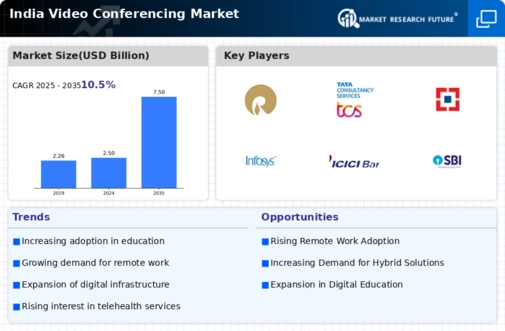Rising Demand for Remote Work Solutions
The increasing trend towards remote work in India is driving the video conferencing sector. As organizations adapt to flexible work arrangements, the need for effective communication tools has surged. According to recent data, approximately 70% of companies in India have adopted remote work policies, necessitating reliable video conferencing solutions. This shift is not only enhancing productivity but also fostering collaboration among teams spread across various locations. The video conferencing market is witnessing a significant uptick in demand as businesses seek to maintain operational efficiency while ensuring employee engagement. Furthermore, the rise of gig economy workers and freelancers is contributing to this demand, as they require seamless communication tools to connect with clients and collaborators. Thus, the evolving work culture in India is a pivotal driver for the video conferencing market.
Growing Adoption of Cloud-Based Solutions
The shift towards cloud-based solutions is emerging as a significant driver for the video conferencing sector in India. Businesses are increasingly recognizing the advantages of cloud technology, such as scalability, cost-effectiveness, and ease of access. Approximately 60% of Indian enterprises are expected to migrate to cloud-based services by 2025, which will likely enhance the demand for cloud-integrated video conferencing tools. These solutions offer flexibility, allowing users to connect from various devices and locations, thereby facilitating seamless communication. Moreover, the integration of cloud services with video conferencing platforms enables features such as recording, screen sharing, and collaboration tools, which are essential for modern business operations. Consequently, the growing preference for cloud-based solutions is anticipated to drive the video conferencing market, as organizations seek to optimize their communication strategies.
Technological Advancements in Connectivity
Technological advancements in connectivity are playing a crucial role in shaping the video conferencing sector in India. The rollout of 5G technology is expected to enhance internet speeds and reduce latency, thereby improving the quality of video calls. With an estimated 50% of urban areas in India projected to have access to 5G by 2026, the video conferencing market is likely to experience substantial growth. Enhanced connectivity will facilitate smoother and more reliable video conferencing experiences, making it an attractive option for businesses and individuals alike. Additionally, the proliferation of high-speed broadband services is further supporting this trend, as more users gain access to stable internet connections. Consequently, the convergence of these technological advancements is expected to propel the video conferencing market forward, enabling more users to leverage these tools for effective communication.
Increased Focus on Education and E-Learning
The growing emphasis on education and e-learning in India is significantly impacting the video conferencing sector. With the rise of online learning platforms and virtual classrooms, educational institutions are increasingly adopting video conferencing tools to facilitate remote learning. Recent statistics indicate that the e-learning market in India is projected to reach $1.96 billion by 2025, highlighting the potential for video conferencing solutions in this sector. Schools and universities are utilizing these platforms to conduct lectures, workshops, and interactive sessions, thereby enhancing the learning experience for students. This trend is further supported by government initiatives aimed at promoting digital education, which is likely to drive the adoption of video conferencing tools in educational settings. As a result, the video conferencing market is poised to benefit from the expanding e-learning landscape in India.
Emergence of Small and Medium Enterprises (SMEs)
The emergence of small and medium enterprises (SMEs) in India is contributing to the growth of the video conferencing sector. SMEs are increasingly recognizing the importance of effective communication tools to enhance collaboration and streamline operations. With approximately 63 million SMEs operating in India, the demand for affordable and efficient video conferencing solutions is on the rise. These enterprises often face budget constraints, making cost-effective video conferencing tools an attractive option for their communication needs. Furthermore, as SMEs expand their reach and engage with clients and partners across different regions, the necessity for reliable video conferencing solutions becomes even more pronounced. This trend indicates that the video conferencing market is likely to experience robust growth as SMEs continue to adopt these technologies to improve their operational efficiency and connectivity.

















Leave a Comment